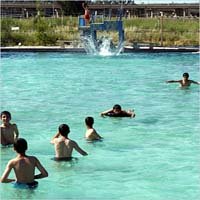|
|
water exercises are good for parts other exercises can't reach!

Try water exercises to improve your mobility
Page Contents
- Benefits of exercising in water
- Safety
- Getting started
- Walking in water
- Variety is the spice of the life
|
[Top]
Water is the ultimate flexible tool, it allows for unrestricted movement, buoyancy and resistance.
- It can reduce water retention
- It increases circulation
- It limbers and strengthens muscles
- It increases balance
- Reduces impact and stress on joints
- It can be done at any age old or young
These factors make aquatic exercises at a hydrotherapy pool ideal for people with disabilities and for the rehabilitation process.
[Top]
Most people will find water exercises beneficial; however it is not suitable for people with certain health conditions. They include
- People with bowel or bladder incontinence
- Open sores
- uncontrollable seizures
- severe osteoporosis
- People who have difficulty breathing. (To be sure, consult your doctor.)
[Top]
Before you get started on an exercise program go and see your doctor or healthcare provider just to get the ok. One of the great things about water exercises is that it is as cheap as chips. You don't need the latest and fanciest equipment to do exercises. You just need.
- Trunks or swimsuit
- Towel
- Access to a pool
If you're looking for a class, look for one that will match your capabilities. Don't be afraid to sit in on a few classes before you join the class. You can learn some of the exercises and get a general feel of the class.
[Top]
- What can be a more natural exercise than the simple walk? This is the simplest form of water aerobic exercise. The recommended time for this aquatic exercise ranges from 3 to 10 minutes of moderate walking. As you walk in chest level water, concentrate on your abdominal breathing and walk using these basic steps:
- First put your heel on the floor and turn on the outside edge of the sole of your foot in the direction of the ball of the foot.
- After that elevate your heel and then stand on your tippy toes for an instant. Subsequently raise your foot, take it forward, and rest it on the floor again. Nice and slowly.
- Put your heel of the other foot on the floor, rotate the outside edge of the sole towards the ball of the foot, and elevate your heel. Employ your toes to drive off, take a pace forward, and land on your heel.
[Top]
- Try alternating the basic water step by walking backward or sideways and alternating the speed. Slow, slow, quick, quick. Slow. Cha, cha, cha!
- Walking backwards will perk up the firmness of your spine and it will strengthen your back muscles.
- Walking sideways will improve the stability of your pelvis and hips.
- Try a tightrope walk. Make believe you are walking along a tightrope. Put one foot in front of the other and make the stride as extended as you can.
- Use your arms to assist with balance as you would when you're walking a tightrope.
- Try a side step and slide exercise. Take a foot step out to the side adopting a broad stance then pull the opposite foot in to meet it. You can increase the speed to slide or shuffle to the side.
- Use your arms to follow the legs out and then in with the side steps, take your arms behind the back as you pull together. Utilize your arms for balance on the sliding motion.
Return from water exercises to hydrotherapy
Back to natural healing home page
|
| |